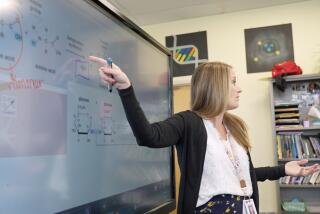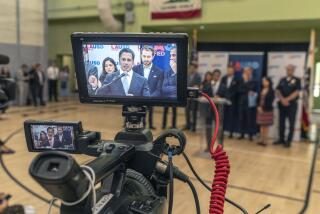Training, Technology Must Go Hand in Hand in Schools
- Share via
In the hands of a trained teacher, personal computers in the classroom can open breathtaking new worlds of knowledge to students. But all too often, teachers know less about how to exploit the vast resources of the digital age than their students--a troubling trend that raises serious questions about the billions spent annually to outfit classrooms with the newest and fastest machines.
Although kids are becoming adept at cruising through cyberspace and printing attractive reports, there’s little evidence that costly efforts to fill classrooms with hardware are actually improving learning. As part of a Times series on computers in the classroom, Valley Edition staff writers Sandy Banks and Lucille Renwick found that few teachers are properly trained in how to incorporate computers into traditional lessons in the basics of reading, math or science.
So what happens? Expensive machines often turn into little more than electronic baby sitters, keeping students occupied with tasks of little or no educational value. For instance, kids at some schools spend as much computer time reading about hot rods and Michael Jordan as they do cross-referencing passages from Shakespeare. Clearly, there is some value in getting students comfortable with computers, which only promise to figure more prominently in daily life. The question is, how much value are students really getting out of the experience?
The Los Angeles Unified School District spent $8.5 million on technology over the 1995-96 school year but--like school districts across the country--has no clear consensus on its best use or on the proper training for teachers. As it is, California’s teacher credential program requires just a single computer class--which ranges in quality and intensity from campus to campus. For older teachers, even that single class would help, but too many are left to figure out for themselves how to operate often cranky computers. A bill pending in the House of Representatives would require districts that receive some federal grants to train teachers in use of technology and then monitor their use of computers in the classroom.
That’s wise, because in the end computers are nothing more than tools with little or no intrinsic educational value of their own. Knowing how to find a Web site is of little use to someone who can’t read what it says once they get there. Likewise, it’s pretty easy to learn which buttons to push to run a regression on a spreadsheet. But understanding the significance of confidence intervals and R-squared values requires another degree of knowledge that must be brought to the computer. And a perfectly formatted term paper won’t pass muster unless the sentences make sense and the arguments are clear.
The bottom line of the information age is information. Computers are great at spitting it out but not so hot at interpreting it in a meaningful way. That requires the same kind of skills that have been taught in classrooms for generations, but to an even greater degree. Computers can do most of the intellectual grunt work, which demands an even deeper understanding of concepts.
Creativity is key. For instance, teachers can assign algebra students to use spreadsheets to rearrange equations--an exercise that both reinforces basic math skills and teaches proper use of complex programs. Younger kids might create charts that track simple experiments--allowing integration of math, science and computers. The common thread of successful lessons is that they use computers to reinforce--not replace--the basics.






